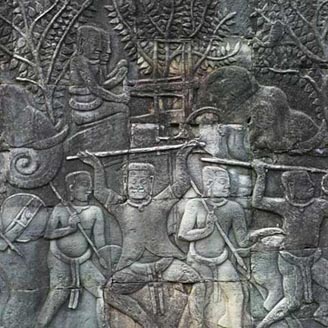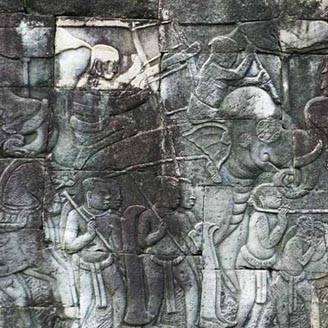Ballista Elephant on:
[Wikipedia]
[Google]
[Amazon]
 A ballista elephant, also known as a Khmer ballista, is a war elephant mounted with a simple or double-bowed
A ballista elephant, also known as a Khmer ballista, is a war elephant mounted with a simple or double-bowed
 The ballista elephant is an evolution from the Austroasiatic crossbow. The discussions as to the origin of the Asian crossbow has been, to a lesser extent, applied to the ballista as well as almost identical war machines have been observed in China. Ballistas mounted on chariots with wheels are also represented on the walls of the Bayon; but the specifically Khmer character of this ballista is that it was mounted on elephants.
The ballista elephant is an evolution from the Austroasiatic crossbow. The discussions as to the origin of the Asian crossbow has been, to a lesser extent, applied to the ballista as well as almost identical war machines have been observed in China. Ballistas mounted on chariots with wheels are also represented on the walls of the Bayon; but the specifically Khmer character of this ballista is that it was mounted on elephants.
 After French explorator
After French explorator
 A ballista elephant, also known as a Khmer ballista, is a war elephant mounted with a simple or double-bowed
A ballista elephant, also known as a Khmer ballista, is a war elephant mounted with a simple or double-bowed ballista
The ballista (Latin, from Greek βαλλίστρα ''ballistra'' and that from βάλλω ''ballō'', "throw"), plural ballistae, sometimes called bolt thrower, was an ancient missile weapon that launched either bolts or stones at a distant ...
which was used by the Angkorian civilization. They are considered as the summit of sophistication of Khmer weaponry comparable to the '' carrobalista'' in the legion of Vegetius
Publius (or Flavius) Vegetius Renatus, known as Vegetius (), was a writer of the Later Roman Empire (late 4th century). Nothing is known of his life or station beyond what is contained in his two surviving works: ''Epitoma rei militaris'' (also ...
.
Description: the Khmer ballista
The ballista elephant is unique to Khmer civilization: the Khmer ballista is an over-proportionedcrossbow
A crossbow is a ranged weapon using an elastic launching device consisting of a bow-like assembly called a ''prod'', mounted horizontally on a main frame called a ''tiller'', which is hand-held in a similar fashion to the stock of a long fir ...
which is more complicated in its mechanism than the Austroasiatic crossbow
The Austroasiatic crossbow which is also known as the Hmong primitive bow, the ''Jarai crossbow'', or the Angkorian crossbow is a crossbow used for war and for hunting in Southeast Asia. It has become a symbol of pride and identity for ethnic gro ...
as it becomes a small catapult
A catapult is a ballistic device used to launch a projectile a great distance without the aid of gunpowder or other propellants – particularly various types of ancient and medieval siege engines. A catapult uses the sudden release of store ...
carried on the backs of elephants. Two bows facing each other are cocked simultaneously by sliding the rope attached to the rear bow by combining the two triggers. It was probably horizontal but, because Khmer stone carvers did not yet master the technique of perspective
Perspective may refer to:
Vision and mathematics
* Perspectivity, the formation of an image in a picture plane of a scene viewed from a fixed point, and its modeling in geometry
** Perspective (graphical), representing the effects of visual per ...
, the sculptor had to represent it vertically.
History
Chinese vs. Austroasiatic origins
 The ballista elephant is an evolution from the Austroasiatic crossbow. The discussions as to the origin of the Asian crossbow has been, to a lesser extent, applied to the ballista as well as almost identical war machines have been observed in China. Ballistas mounted on chariots with wheels are also represented on the walls of the Bayon; but the specifically Khmer character of this ballista is that it was mounted on elephants.
The ballista elephant is an evolution from the Austroasiatic crossbow. The discussions as to the origin of the Asian crossbow has been, to a lesser extent, applied to the ballista as well as almost identical war machines have been observed in China. Ballistas mounted on chariots with wheels are also represented on the walls of the Bayon; but the specifically Khmer character of this ballista is that it was mounted on elephants.
Use by Angkorian empire
It appears that the ballista was not of Khmer origin. However, it was a combination of various elements of Chinese warfare equipment, which was upcycled by creatively mounting it on the back of a war elephant. The elephant ballista is represented in the bas-relief of bothBanteay Chhmar
Banteay Chhmar ( km, បន្ទាយឆ្មារ ) is a commune ( khum) in Thma Puok District in Banteay Meanchey province in northwest Cambodia. It is located 63 km north of Sisophon and about 20 km east of the Thai border. The ...
and Bayon
The Bayon ( km, ប្រាសាទបាយ័ន, ) is a richly decorated Khmer temple related to Buddhism at Angkor in Cambodia. Built in the late 12th or early 13th century as the state temple of the King Jayavarman VII ( km, ព្រះ ...
. However, the carvings of the Bayon are more intricate and shows more technical mechanisms, the one in Banteay Chhmar shows a certain simplification of the weapon. In Bayon, the elephant ballista is loaded by soldiers in Cham uniform, suggesting that the Khmer ballista may have been integrated into the Angkorian army by Cham mercenaries. In both cases, they appear only in the great military parade which may suggest that the elephant ballista never made it to the battlefield for practical reasons. By all means, the ballista elephant is evidence of the technological sophistication of the Khmer army and weaponry.
Findings from modern archeology
 After French explorator
After French explorator Henri Mouhot
Alexandre Henri Mouhot (May 15, 1826 — November 10, 1861) was a French naturalist and explorer of the mid-19th century. He was born in Montbéliard, Doubs, France, near the Swiss border, but spent his childhood in Russia and, possibly, parts ...
led by Catholic missionary Emile Bouillevaux was the first foreigner to explore Angkor Wat with an archeological intention in the 1860, the discovery for the elephant ballista exerted a certain fantasy on the imagination of foreigners. Beyond fantasy, it also contributed to restoring the timeline of Cambodian history. It was first studied by Georges Groslier in 1921.
First of all, the complexity of the elephant ballista which was represented in the Bayon and not in Angkor Wat was one of the factors that led Georges Coedes to doubt his own chronology. In fact, he mistakenly believed that the Bayon was anterior to Angkor Wat, but the presence of the elephant ballista and other sophisticated military apparel in Bayon and its absence in Angkor Wat, which would have been a terrible recession, was a conundrum for him.
The elephant ballista also helped archeologists better understand the role, influence of and relationship of the Khmer civilization with China. In fact, it was first believed that the China ballista was taken from the Angkorian model. Hervey de Saint-Denys Hervey is both an English surname and a masculine given name, probably derived from French Hervé. Notable people with the name include:
Surname:
* Lord Alfred Hervey (1816–1875), English politician
* Lord Arthur Hervey (1808–1894), English bis ...
who was a Sinologist himself believed some elements of Chinese artillery, particularly the double-bow, could have been of Khmer origin. However, the giant ballista were already in use in 1127 during the Jingkang incident during the Jin–Song Wars
The Jin–Song Wars were a series of conflicts between the Jurchen-led Jin dynasty (1115–1234) and the Han-led Song dynasty (960–1279). In 1115, Jurchen tribes rebelled against their overlords, the Khitan-led Liao dynasty (916–1125) ...
. In 1282, the Cham defended themselves against Mongol invasions using such ballistas which were also found in Burma during the Second Mongol invasion of Burma
The second Mongol invasion of Burma by the Yuan dynasty under Temür Khan was repulsed by the Burmese Myinsaing Kingdom in 1301.
Background
After the first invasion by the Yuan dynasty, Narathihapate fled Pagan. Already experienced commanders ...
. Therefore, rather than Khmer origin of the mounted bow, the spread of the ballista across Asia shows how Chinese warfare in the region played a major in the development of warfare technology in Asia.
See also
*Carroballista
Carroballista was an ancient, cart-mounted ballista, a type of mobile field artillery. According to the Roman author Vegetius (''Epitoma rei militaris'' II.25), each legion had 55 ''carroballistae'' (one per ''centuria'') which were arrow/bolt-sho ...
References
Bibliography
* * {{DEFAULTSORT:Ballista Elephant War elephants Ancient warfare Animal armour History of South Asia Combat occupations